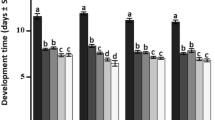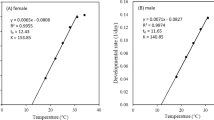Abstract
The effects of temperature on induction and stability of parasitization of less preferred factitious host (the Angoumois grain moth, Sitotroga cerealella) eggs by Trichogramma principium females were studied under laboratory conditions. The percentage of parasitizing females at 15°C was significantly lower than that at 20, 25, and 30°C. At constant temperatures of 15, 20, 25, and 30°C, mean durations of pre-oviposition periods were 6.5, 2.1, 0.9, and 0.6 days, respectively (differences were significant between all regimens). In most of females, parasitization induced by high temperature (25°C) continued after the temperature decrease to 15°C. These results suggest that although emerged females are ready to lay eggs, rather prolonged pre-oviposition period may precede parasitization of less preferred hosts, and the duration of this period may depend on temperature.
Similar content being viewed by others
References
Adashkevich, B.P. and Umarova, T.M., “Characteristics of Trichogramma principium (Hymenoptera, Trichogrammatidae) Development under Laboratory Conditions,” Zool. Zh. 64(9), 1413–1417 (1985) [in Russian].
Atamirzaeva, T.M., “Biological Characteristics of Trichogramma sugonjaevi (Hymenoptera, Trichogrammatidae) under Laboratory Conditions,” in Trichogramma (Biology, Development, Application), Proc. of the Third All-Union Conference on Trichogramma (Kishinev, 1991), pp. 5–6 [in Russian].
Bower, W.R. and Stern, V.M., “Effect of Temperature on the Production of Males and Sexual Mosaics in Uniparental Race of Trichogramma semifumatum (Hymenoptera, Trichogrammatidae).” Ann. Entomol. Soc. Amer. 59(4), 823–824 (1966).
Chernyshev, V.B., Insect Ecology (Moscow, 1996) [in Russian].
Honda, J.Y and Luck, R.F., “Age and Suitability of Amorbia cuneana (Lepidoptera: Tortricidae) and Sabulodes aegrotata (Lepidoptera: Geometridae) Eggs for Trichogramma platneri (Hymenoptera: Trichogrammatidae),” Biol. Contr. 18(1), 79–85 (2000).
Honěk, A. and Kocourek, F., “Temperature and Development Time in Insects: a General Relationship Between Thermal Constants,” Zool. Jb. Syst. 117, 401–439 (1990).
Lactin, D.J., Holliday, N.J., Johnson, D.L., and Craigen, R., “Improved Rate Model of Temperature-Dependent Development by Arthropods,” Environ. Entomol. 24(1), 68–75 (1995).
Mansfield, S. and Mills, N.J., “Host Egg Characteristics, Physiological Host Range, and Parasitism Following Inundative Releases of Trichogramma platneri (Hymenoptera, Trichogrammatidae) in Walnut Orchards,” Environ. Entomol. 31(4), 723–731 (2002).
Papaj, D.R., “Automatic Behavior and the Evolution of Instinct: Lessons from Learning in Parasitoids,” in Insect Learning (N.Y., 1993), pp. 243–272.
Pavlik, J., “The Effect of Temperature on Parasitization Activity in Trichogramma spp. (Hymenoptera, Trichogrammatidae),” Zool. Jahrbuch. Allgemeine Zool. Physiol. 96(3), 417–425 (1992).
Reznik, S.Ya., “Intraspecific Variations of Host Specificity in Insect Parasitoids (Using Trichogramma (Hymenoptera, Trichogrammatidae) as an Example),” Entomol. Obozr. 74(3), 507–515 (1995) [in Russian].
Reznik, S.Ya. and Umarova, T.Ya., “Reaction of Trichogramma cacoeciae (Hymenoptera, Trichogrammatidae) Females on Duration of Host Eggs Development,” Zool. Zh. 64(5), 709–714 (1985) [in Russian]
Reznik, S.Ya. and Umarova, T.Ya., “Influence of Host Population Density on Parasitization Intensity by Trichogramma Females,” Zool. Zh. 68(12), 30–37 (1989) [in Russian].
Reznik, S.Ya., Voinovich, N.D. and Umarova, T.Ya., “Experimental Studies of Dynamics of the Percentage of Ovipositing Females and their Fecundity in Successive Generations of Trichogramma (Hymenopetra, Trichogrammatidae),” Zool. Zh. 75(3), 375–382 (1996) [Entomol. Rev. 76 (1), 138–143 (1996)].
Reznik, S.Ya., Umarova, T.Ya. and Voinovich, N.D., “The Influence of Previous Host Age on Current Host Acceptance in Trichogramma,” Entomol. Exp. Appl. 82(2), 153–157 (1997).
Reznik, S.Ya., Umarova, T.Ya. and Voinovich, N.D., “Egg Retention in the Presence of a Host in Trichogramma Females,” J. Appl. Entomol. 122(9–10), 555–559 (1998).
Reznik, S.Ya., Voinovich, N.D. and Umarova, T.Ya., “Comparative Behavioral Analysis of Ovipositing Females and Females with Egg Retention in Trichogramma principium (Hymenoptera, Trichogrammatidae),” Entomol. Obozr. 80(3), 545–555 (2001a) [Entomol. Rev. 81 (8), 895–903 (2001a)].
Reznik, S.Ya., Umarova, T.Ya. and Voinovich, N.D., “Long-term Egg Retention and Parasitization in Trichogramma principium (Hymenoptera, Trichogrammatidae),” J. Appl. Entomol. 125(4), 169–175 (2001b).
Roitberg, B.D., “Towards a General Theory of Host Acceptance by Aphid Parasitoids,” Europ. J. Entomol. 90(4), 369–376 (1993).
Scott, M., Berrigan, D. and Hoffmann, A.A., “Costs and Benefits of Acclimation to Elevated Temperature in Trichogramma carverae,” Entomol. Exp. Appl. 85(3), 211–219 (1997).
Smith, S.M., “Biological Control with Trichogramma: Advances, Successes, and Potential of their Use,” Ann. Rev. Entomol. 41, 375–406 (1996).
Sorokina, A.P., “New Data on Taxonomy and Biology of the Genus Trichogramma (Hymenoptera, Chalcidoidea),” Zool. Zh. 57(9), 1442–1444 (1978) [in Russian].
Takada, Y., Kawamura, S. and Tanaka, T., “Biological Characteristics: Growth and Development of the Egg Parasitoid Trichogramma dendrolimi (Hymenoptera: Trichogrammatidae) on the Cabbage Armyworm Mamestra brassicae (Lepidoptera: Noctuidae),” Appl. Entomol. Zool. 35(3), 369–379 (2000).
Veenstra, K.H. and Byrne, D.N., “The Effects of Physiological Factors and Host Plant Experience on the Ovipositional Activity of the Sweet Potato Whitefly, Bemisia tabaci,” Entomol. Exp. Appl. 89(1), 15–23 (1998).
Viktorov, G.A., Ecology of Insect Parasitoids (Moscow, 1976) [in Russian].
Vinson S.B., “The behavior of parasitoids,” in Comprehensive insect physiology, biochemistry and pharmacology (Oxford, 1985), Vol. 9, pp. 417–469.
Wang, B., Ferro, D.N., “Functional Responses of Trichogramma ostriniae (Hymenoptera: Trichogrammatidae) to Ostrinia nubilalis (Lepidoptera, Pyralidae) under Laboratory and Field Conditions,” Environ. Entomol. 27(3), 752–758 (1998).
Zaslavskiy, V.A. and May Phu Qui, “An Experimental Study of some Factors Affecting Fecundity in Trichogramma Westw. (Hymenoptera, Trichogrammatidae),” Entomol. Obozr. 61(4), 724–736 (1982) [in Russian].
Author information
Authors and Affiliations
Additional information
Original Russian Text © S. Ya. Reznik, N. P. Vaghina, 2006, published in Zoologicheskii Zhurnal, 2006, Vol. 85, No. 1, pp. 48–53.
Rights and permissions
About this article
Cite this article
Reznik, S.Y., Vaghina, N.P. Temperature effects on induction of parasitization by females of Trichogramma principium (Hymenoptera, Trichogrammatidae). Entmol. Rev. 86, 133–138 (2006). https://doi.org/10.1134/S0013873806020023
Received:
Issue Date:
DOI: https://doi.org/10.1134/S0013873806020023




